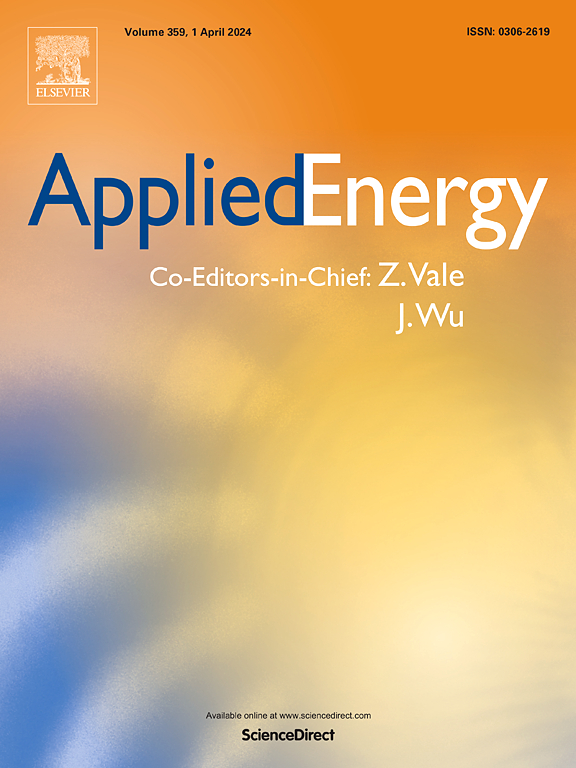有效热管理的硅光伏组件的辐射调节:一个潜在的分析
IF 11
1区 工程技术
Q1 ENERGY & FUELS
引用次数: 0
摘要
提高辐射冷却能力或反射所有亚带隙光子以实现有效的热管理引起了人们的极大兴趣。文献中已经有许多关于增强的相关研究,但光电转换随工作条件的变化仍然表现出显著的可变性,通过增强散热或抑制热产生的机制完全不同。本文对辐射调节技术进行了全面的潜力分析。在我们的模拟框架的基础上,集成了一个经过改进的热网络,其中包含15个节点,覆盖了PV模块的整个结构,从而能够精确确定温度趋势。据此计算光伏组件的基本性能和能量分布,以及组件的产热和散热功率变化。揭示了温度下降背后的优化机制,并确定了不同工况下实际的温度下降,供参考。结果表明,对于硅光伏组件,通过抑制所有非贡献光子的辐射调节方案可以消除带隙以下损耗和抑制寄生吸收,并且比提高其辐射冷却能力更有效。当入射太阳辐照强度分别为600、800和1000 W/m2时,与原模组相比,在拒绝所有非贡献光子的情况下,平均温度分别降低2.86℃、3.75℃和4.60℃,仅将发射率提高到1时,平均温度降低为0.68℃、0.77℃和0.86℃,提高亚带隙反射能力后,平均温度降低为0.64℃、0.70℃和0.78℃。此外,所有的性能增强都会随着风速的增加而减弱,并且增强发射率更适合在热环境中应用,而反射无用光子更适合在冷环境中应用。本文章由计算机程序翻译,如有差异,请以英文原文为准。
Radiation regulation of silicon photovoltaic modules for effective thermal management: A potential analysis
Enhancing the radiative cooling capacity or reflecting all the sub-bandgap photons to realize effective thermal management has elicited great interest. Numerous related investigations of the enhancement have been covered in literature, while the photoelectric conversion along with the working conditions still exhibit significant variability, and the mechanisms through enhancing heat dissipation or suppressing heat generation are entirely distinct. Herein, a comprehensive potential analysis is conducted on the radiation regulation technologies. Building upon our simulation framework, a modified thermal network with refined fifteen nodes that cover the entire structure of the PV module is integrated, enabling precise determination of the temperature trend. Accordingly, the basic properties of the PV module and the energy distribution are calculated, along with the power change of heat generation and dissipation of the module. The optimization mechanisms behind the temperature decline are revealed, and the practical temperature reductions under different working conditions are determined for reference. The results reveal that, for a silicon PV module, the radiation regulation scheme through rejecting all the non-contribution solar photons can eliminate below bandgap loss and suppress parasitic absorption and is much more efficient than enhancing its radiative cooling capacity. The average temperature reductions can reach up to 2.86 °C, 3.75 °C, and 4.60 °C respectively by rejecting all non-contribution photons compared to the original module with the incoming solar irradiance intensity of 600, 800, and 1000 W/m2, while the values decrease to 0.68 °C, 0.77 °C and 0.86 °C if only the emissivity is improved to unity, and further drop to 0.64 °C, 0.70 °C and 0.78 °C if the sub-bandgap reflection capacity has been improved. Additionally, all the performance enhancements will be diminished with the wind speed, and enhancing emissivity is more suitable to be applied in hot environment, whereas reflecting useless photons prefers cold.
求助全文
通过发布文献求助,成功后即可免费获取论文全文。
去求助
来源期刊

Applied Energy
工程技术-工程:化工
CiteScore
21.20
自引率
10.70%
发文量
1830
审稿时长
41 days
期刊介绍:
Applied Energy serves as a platform for sharing innovations, research, development, and demonstrations in energy conversion, conservation, and sustainable energy systems. The journal covers topics such as optimal energy resource use, environmental pollutant mitigation, and energy process analysis. It welcomes original papers, review articles, technical notes, and letters to the editor. Authors are encouraged to submit manuscripts that bridge the gap between research, development, and implementation. The journal addresses a wide spectrum of topics, including fossil and renewable energy technologies, energy economics, and environmental impacts. Applied Energy also explores modeling and forecasting, conservation strategies, and the social and economic implications of energy policies, including climate change mitigation. It is complemented by the open-access journal Advances in Applied Energy.
 求助内容:
求助内容: 应助结果提醒方式:
应助结果提醒方式:


